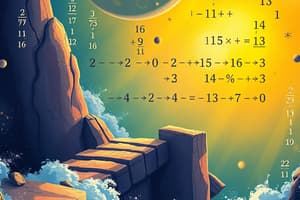Podcast
Questions and Answers
What is the result when you add $275$ and $148$?
What is the result when you add $275$ and $148$?
- $430$
- $418$
- $425$
- $423$ (correct)
If you divide $36$ by $6$, what is the quotient?
If you divide $36$ by $6$, what is the quotient?
- $7$
- $6$ (correct)
- $8$
- $5$
Which of the following fractions is greater: $3/4$ or $2/3$?
Which of the following fractions is greater: $3/4$ or $2/3$?
- Both are equal
- $3/4$ (correct)
- Cannot determine
- $2/3$
What is the product of $8$ and $7$?
What is the product of $8$ and $7$?
What operation should be used to solve the word problem: 'A baker has $20$ cupcakes and gives away $7$. How many cupcakes does he have left?'
What operation should be used to solve the word problem: 'A baker has $20$ cupcakes and gives away $7$. How many cupcakes does he have left?'
If I have $15$ apples and I want to divide them equally among $3$ friends, how many apples will each friend receive?
If I have $15$ apples and I want to divide them equally among $3$ friends, how many apples will each friend receive?
What is the difference between $102$ and $58$?
What is the difference between $102$ and $58$?
When adding $1/4$ and $1/2$, what is the resulting fraction?
When adding $1/4$ and $1/2$, what is the resulting fraction?
What is $12$ multiplied by $11$?
What is $12$ multiplied by $11$?
How would you express the statement: 'John has $15$ marbles and finds $5$ more' as an equation?
How would you express the statement: 'John has $15$ marbles and finds $5$ more' as an equation?
Flashcards
Addition
Addition
Combining numbers to find a total.
Subtraction
Subtraction
Removing a number from another.
Sum
Sum
The result of addition.
Difference
Difference
Signup and view all the flashcards
Multiplication
Multiplication
Signup and view all the flashcards
Division
Division
Signup and view all the flashcards
Product
Product
Signup and view all the flashcards
Quotient
Quotient
Signup and view all the flashcards
Fractions
Fractions
Signup and view all the flashcards
Numerator
Numerator
Signup and view all the flashcards
Study Notes
Addition and Subtraction
-
Concepts:
- Understanding of basic addition (combining numbers).
- Understanding of subtraction (removing one number from another).
-
Skills:
- Adding and subtracting numbers up to 3 digits.
- Using mental strategies (counting on, counting back).
- Using number lines for visual support.
-
Key Terms:
- Sum (result of addition).
- Difference (result of subtraction).
Multiplication and Division
-
Concepts:
- Understanding multiplication as repeated addition.
- Understanding division as the process of splitting into equal parts or groups.
-
Skills:
- Multiplying numbers up to 12 x 12.
- Dividing numbers with single-digit divisors.
- Recognizing multiplication and division facts (e.g., 3 x 4 = 12 implies 12 ÷ 3 = 4).
-
Key Terms:
- Product (result of multiplication).
- Quotient (result of division).
Fractions
-
Concepts:
- Understanding fractions as parts of a whole.
- Recognizing and identifying fractions (1/2, 1/4, 3/4).
-
Skills:
- Comparing and ordering fractions with like denominators.
- Adding and subtracting simple fractions (like denominators).
-
Key Terms:
- Numerator (top number in a fraction).
- Denominator (bottom number in a fraction).
Word Problems
-
Concepts:
- Applying math skills to solve real-life scenarios.
-
Skills:
- Identifying relevant information in a problem.
- Choosing the correct operation (addition, subtraction, multiplication, division) based on the context.
- Writing equations based on word problems.
-
Strategies:
- Drawing diagrams or using objects to visualize problems.
- Estimating answers before calculating.
- Checking answers for reasonableness.
Addition and Subtraction
- Basic addition involves combining numbers to find a total.
- Subtraction is the operation of removing a number from another.
- Skills include adding and subtracting up to three-digit numbers effectively.
- Mental strategies include counting on and counting back to assist with calculations.
- Number lines provide visual support for understanding addition and subtraction.
- Key Terms:
- Sum: The result obtained from addition.
- Difference: The result obtained from subtraction.
Multiplication and Division
- Multiplication is conceptualized as repeated addition of the same number.
- Division is understood as the process of splitting a quantity into equal groups.
- Mastery includes multiplying numbers up to 12 x 12 and dividing by single-digit divisors.
- Recognizes that multiplication and division are inverse operations (e.g., 3 x 4 = 12 implies 12 ÷ 3 = 4).
- Key Terms:
- Product: The outcome of a multiplication operation.
- Quotient: The outcome of a division operation.
Fractions
- Fractions represent parts of a whole with a numerator and a denominator.
- Common fractions include 1/2, 1/4, and 3/4.
- Skills involve comparing and ordering fractions that share the same denominator.
- Addition and subtraction of simple fractions is limited to those with like denominators.
- Key Terms:
- Numerator: The top number indicating how many parts are considered.
- Denominator: The bottom number indicating the total number of equal parts.
Word Problems
- Word problems require applying mathematical skills to real-life situations.
- Skills involve identifying critical information and determining the appropriate operation needed.
- Writing equations based on the scenario aids in solving the problem accurately.
- Strategies for problem-solving include:
- Drawing diagrams or utilizing physical objects for visualization.
- Estimating potential answers prior to calculation to check feasibility.
- Verifying the reasonableness of answers post-calculation.
Studying That Suits You
Use AI to generate personalized quizzes and flashcards to suit your learning preferences.




